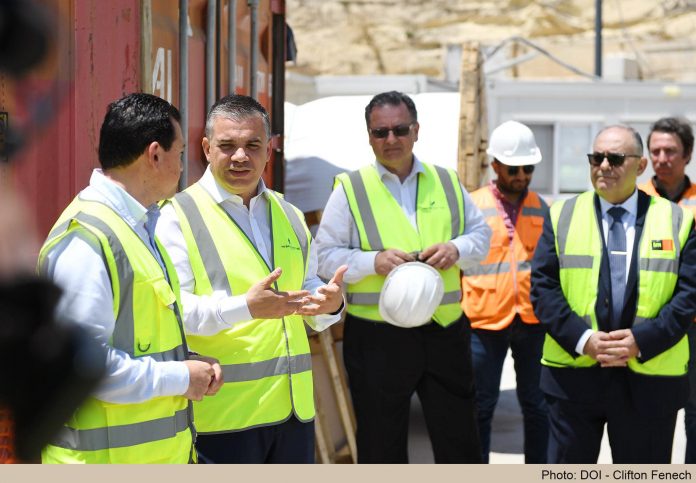Infrastructure Malta lays high-voltage cables for shore-to-ship electricity in the Grand Harbour
Infrastructure Malta is completing the laying of the high voltage underground cables that will energise shore-to-ship electricity systems for cruise liners visiting Malta, cutting 90% of their air pollution in the Grand Harbour.
This was announced by Minister for Transport, Infrastructure and Capital Projects Aaron Farrugia together with Parliamentary Secretary for European Funds Chris Bonett, Infrastructure Malta CEO Frederick Azzopardi, and Transport Malta Chairman Joseph Bugeja.
The Grand Harbour Clean Air Project (GHCAP) is a €49.9 million environmental investment to develop the electricity infrastructure for cruise liners and cargo ships to switch off their gas-oil or heavy-fuel-oil-fired engines and plug in to shoreside electricity to energise their onboard systems whilst they are berthed at port.
Through this project, which is co-financed by the EU’s Connecting Europe Facility, Infrastructure Malta is improving air quality for 17,000 families living in the Grand Harbour area. As soon as it is complete, this project will be managed by Transport Malta.
“We are continuing to invest in our priorities according to our vision for the future of Malta: better air quality — and in turn, better health and quality of life for families — as well a cleaner, more resilient environment as we continue to address the challenges of climate change”, said Minister Farrugia, explaining that the first shore-to-ship connections of the cruise liner quays at Pinto Wharf, Floriana and Boiler Wharf, Senglea, are scheduled to be commissioned in the second quarter of 2023, making Malta one of the first in Europe to adopt this environmental technology on a port-wide scale.
This week, IM laid the last stretch of underground cables of the eight-kilometre 33-kilovolt network that will distribute electricity from an Enemalta plc distribution centre at Jesuits Hill Marsa to the project’s two new frequency converter stations at the Deep Water Quay, in Marsa and Boiler Wharf, in Senglea. This summer, it will be completing this backbone network with the submerging of 800 metres of subsea cables from Bridge Wharf, Marsa to Coal Wharf, Corradino.
Minister Farrugia explained that preliminary studies indicate that through GHCAP, within 20 years Malta will save up to €375 million in costs linked to the measurable consequences of air pollution, such as effects on health, the natural environment, infrastructure, and agriculture. It will also reduce the impact of cruise liner noise and engine vibrations in the Grand Harbour area.
This project will drastically reduce the emissions of cruise ships visiting Malta. By switching off their auxiliary engines, cruise liners will emit 93% less nitrogen oxides, 92.6% less particulate matter and 99.6% less sulphur dioxide. These pollutants are among the principal causes of respiratory illnesses and other health problems. GHCAP will also cut 39.6% of the cruise liners’ carbon dioxide emissions, which contribute to the climate emergency.
Parliamentary Secretary Chris Bonett said that €45 million from this project is funded by European Funds. He explained that for the part of the project on which works are currently ongoing, €22 million are being invested from the Connecting Europe Facility. Chris Bonett said that due to the importance of this project, Malta negotiated additional funds with the European Commission.










